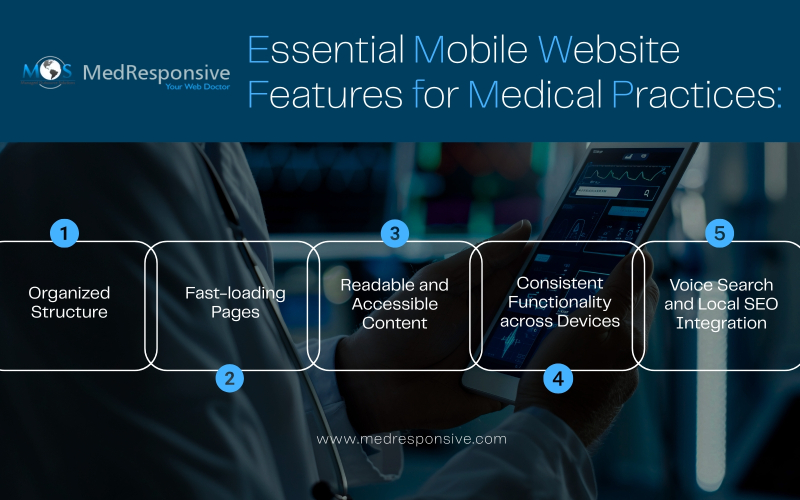A healthcare website is the doorway to optimized online presence, increased patient intake, and enhanced financial health for medical organizations. However, with smartphone search becoming the dominant form of online searching, practices that do not prioritize mobile optimization for healthcare websites do not stay relevant with users.
As a result, you may miss out on a huge chunk of prospective patients who are looking for your healthcare services. Partnering with a healthcare SEO agency can help address this gap by aligning your digital presence with evolving patient behaviors. The growing trends in healthcare such as wearable health tech integration, AI-driven personalization, and omni channel communication mode, reflect a shift towards patient-centric experience. Mobile optimization is a critical component that ties directly into all these trends by ensuring that healthcare sites are accessible, responsive, and user-friendly across a wide range of devices.
Why Mobile Optimization Matters for Healthcare Practices
Owing to its convenience, accessibility, and features such as voice search, accessing the internet through mobile devices is the preferred method for many users. For medical organizations, this unlocks new possibilities in patient acquisition and revenue streams when implemented correctly. As Google has switched to mobile-first indexing for ranking purposes, websites now must be designed and optimized with mobile users in mind. So, if your site isn’t optimized for smart phones and tablets, you not only risk losing patients but also online visibility in search results.
With mobile-optimized version becoming a necessity, here are the several key benefits of mobile-friendly medical websites for practices:
- Increased appointments: Optimized sites that allow for online booking through features such as intuitive forms, personalized patient portals, and secure payment gateways are better positioned at attracting new patients.
- Better user engagement: An optimized site is easy-to-navigate, loads faster, and properly formatted for users, allowing them to find the information needed quickly, thereby creating an overall better user experience and engagement rate.
- Enhanced service: Optimized websites allow patients to quickly reach support for any concerns or questions, whether it’s through live chat, calls, or support forms, providing a seamless patient-provider communication experience.
- Improved SEO: Optimizing for mobile-first indexing allows search engines to find and index your site easily. This can improve your Search Engine Results Page (SERP) rankings, leading to higher visibility and better organic traffic for your website.
- Higher conversion rate: A smartphone-friendly site can turn engagement into action by allowing patients to browse services, read reviews, or book appointments effortlessly through their phones. Smooth navigation, clear calls-to-action, and multiple payment options all work together to turn casual visitors into actual patients.
Best Mobile-friendly Features for Medical Websites
Staying competitive in healthcare is no longer just about rendering excellent treatment – it’s also about accessibility and convenience. A responsive website helps practices stay ahead by keeping patients connected, informed, and engaged. When a patient lands on your site from their phone, they’re often in a moment of need. If your site fails to meet them with speed, clarity, and ease of use, chances are they’ll bounce and move on to a competitor whose site does.
What does a mobile-optimized site actually look like in practice?
- Organized Structure
When someone visits your site from their phone, they may not have the patience to search for what they need. A clean, logical structure is essential. That means clear menus with intuitive labels, uncluttered layouts, and prominent buttons that actually feel clickable on a smaller screen. The goal is to remove friction as every second a user spends wondering where to click is a second closer to them giving up. A well-organized smartphone site anticipates the user’s intent and guides them toward the answers or actions they came for.
- Fast-loading Pages
Slow pages frustrate users, and they may end up leaving your website, affecting its bounce rate. Optimization techniques such as compressing images, minimizing scripts, enabling browser caching, and using reliable hosting provider cut down load times, help to increase page visit duration and retain visitors.
- Readable and Accessible Content
Implement user-specific functionalities for short, digestible content consumption such as headers, short paragraphs, bullet points, and avoid walls of text to better help users scan for what they need. It must be designed to cater to all users, including those with disabilities. Accessibility features such as text resizing, color contrast, and screen reader compatibility are essential.
- Consistent Functionality across Devices
Whether a patient is using an older iPhone, a new Android tablet, or a small-screened smartphone, the site should function smoothly. Maintain a user-friendly site by ensuring that the layout, fonts, images, and navigation of the website automatically adjust to fit different screen sizes. Buttons shouldn’t overlap, text shouldn’t run off-screen, and interactive elements like forms should remain easy to use and responsive.
- Voice Search and Local SEO Integration
As voice search in healthcare continues to grow, many users are now turning to their devices for nearby clinics, urgent care, or specialists. Integrate natural, conversational keywords and structured data to support voice-driven queries. In addition, incorporating local SEO strategies such as up-to-date Google Business Profile listings, embedded maps, and location-based keywords help your site appear in relevant local searches.
Mistakes Practices Must Avoid
Mobile optimization isn’t just about fitting content onto a smaller screen. Here are a few missteps that can do more harm than good:
- Using Desktop-first Design with Adjustments
A website built primarily for desktop and then “shrunk” for mobile devices rarely works well. Mobile-first design, by contrast, starts with the limitations and needs of smartphone users in mind. Layouts, navigation, and functionality are designed to work smoothly on smaller screens first, then adapted to larger devices.
- Neglecting Medical Website SEO for Smartphones
Title tags, meta descriptions, and on-page keywords should still be optimized for mobile search behavior, which is often more local and immediate.
- Inconsistent Branding across Devices
If your smartphone version of the site feels different from your desktop version, it can confuse or alienate users. Brand consistency builds trust and credibility for users.
Seek Expert Assistance for Mobile Optimization
Mobile optimization isn’t a passing tech trend, it’s the new baseline. A fast, intuitive healthcare website design is more than about looking decent on a phone screen, it’s about performance, usability, and aligning with patient behavior. An outdated site that lags or frustrates users can quietly erode the patient’s trust in your practice. That’s where expert guidance comes in. Practices can hire web designing professionals from reputable healthcare website development agencies to fine-tune the technical details while keeping the user experience front and center. From optimizing for local search to ensuring your brand stays consistent across every screen, the right support can turn your mobile site from functional into a strategic asset.





